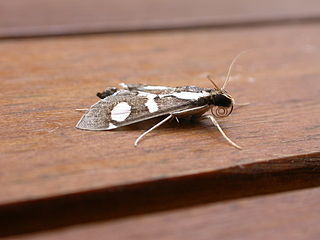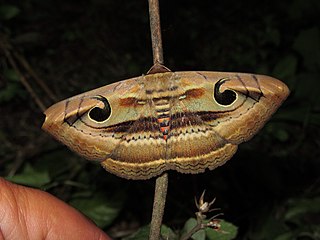Related Research Articles

Campaea margaritata, commonly known in the UK as the light emerald, is a moth of the family Geometridae. The species was first described by Carl Linnaeus in his 1767 12th edition of Systema Naturae. It is widely distributed throughout Europe, the Near East and North Africa.

Glyphodes is a genus of moths of the family Crambidae described by Achille Guenée in 1854.

Spirama is a genus of moths in the family Erebidae first described by Achille Guenée in 1852.
Bracca is a genus of moths in the family Geometridae erected by Jacob Hübner in 1820.

Eudocima phalonia, the common fruit-piercing moth, is a fruit piercing moth of the family Erebidae. The species was first described by Carl Linnaeus in his 1763 Centuria Insectorum. It is found in large parts of the tropics, mainly in Asia, Africa and Australia but introduced into other areas such as Hawaii, New Zealand and the Society Islands. It is one of major fruit pests in the world.

Glyphodes bivitralis is a moth of the family Crambidae described by Achille Guenée in 1854. It is native to south-east Asia, including Hong Kong, India, Japan, Taiwan and Thailand. It is also found in Queensland and Hawaii.

Glyphodes negatalis, the karanj defoliator, is a moth of the family Crambidae. The species was first described by Francis Walker in 1859. It has a wide range in the tropics, including South Africa, The Gambia, Mali, India, Sri Lanka, Hong Kong, Japan and eastern Australia.

Glyphodes bicolor is a species of moth of the family Crambidae described by William John Swainson in 1821. It is widely distributed in the Old World tropics, including South Africa, China, Thailand, India, New Guinea and Australia.

Spirama retorta, the Indian owlet-moth, is a moth of the family Erebidae. The species was first described by Carl Alexander Clerck in 1764. It is found in China, Korea, Japan (Honshu), India, Nepal, Bangladesh, Thailand, Cambodia, Myanmar, Vietnam, Taiwan, Sri Lanka, Malaysia, the Philippines (Luzon), Indonesia ,Japan.

Glyphodes multilinealis, the fig-tiger-moth, is a species of moth of the family Crambidae described by George Hamilton Kenrick in 1907. It is found in Papua New Guinea, Fiji, Niue, the Cook Islands, the Society Islands, in Australia and Japan.
Glyphodes doleschalii is a moth of the family Crambidae described by Julius Lederer in 1863. It is found in Queensland in northern Australia.

Aethes hartmanniana, the scabious conch, is a moth of the family Tortricidae. It was described by Carl Alexander Clerck in 1759. It is found in most of Europe, Asia Minor, Armenia and the southern Urals. The species occurs in chalky and limestone habitats.

Glyphodes canthusalis is a moth in the family Crambidae. It was described by Francis Walker in 1859. It is found in Taiwan, mainland India, Sri Lanka and on the Andaman Islands, Vietnam, Indonesia and Australia.

Glyphodes pyloalis, the lesser mulberry snout moth, lesser mulberry pyralid or beautiful glyphodes moth, is a moth in the family Crambidae. It was described by Francis Walker in 1859. It is found in Iran, China, Japan, India, Indonesia (Sumatra), Sri Lanka, Taiwan, the Democratic Republic of the Congo, Equatorial Guinea, Mozambique and North America, where it has been recorded from Florida, Maryland, North Carolina, South Carolina and Virginia.

Glyphodes stolalis is a moth in the family Crambidae. It was described by Achille Guenée in 1854. It is found in Cameroon, the Comoros, the Democratic Republic of the Congo, Kenya, Réunion, Madagascar, the Seychelles, South Africa (KwaZulu-Natal), the Gambia, Uganda, Zimbabwe, China, India, Indonesia (Sulawesi), Sri Lanka, Japan, Taiwan, Thailand and Australia.
Glyphodes basifascialis is a moth in the family Crambidae. It was described by George Hampson in 1899. It is found in Australia, Cameroon, the Democratic Republic of the Congo, the Seychelles, South Africa and Tanzania.
Glyphodes cosmarcha is a moth in the family Crambidae. It was described by Edward Meyrick in 1887. It is found in Thailand, New Guinea and in Australia, where it has been recorded from Queensland and New South Wales.
Glyphodes flavizonalis is a moth in the family Crambidae. It was described by George Hampson in 1898. It is found in Australia, where it has been recorded from Queensland.
References
- ↑ Nuss, M.; et al. (2003–2014). "GlobIZ search". Global Information System on Pyraloidea. Retrieved 15 July 2014.
- ↑ Herbison-Evans, Don & Crossley, Stella (24 January 2011). "Glyphodes margaritaria (Clerck, 1764)". Australian Caterpillars and their Butterflies and Moths. Retrieved 24 January 2019.
| This Glyphodes-related article is a stub. You can help Wikipedia by expanding it. |